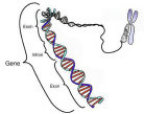Creation and Evolution: The Real Conflict
There is no conflict between special creation and micro evolution. Micro evolution is
simply changes within species. Micro evolution is observable today.
Children are not identical to their parents. “No one doubts
that descent with modification occurs in the course of normal biological reproduction. The question is whether descent with modification
accounts for the origin of new species - in fact, of every species.” [1]
The conflict is between special creation and macro
evolution. Special creation follows the biblical Genesis account whereby God created separately each kind of physical life on earth
during days three, five and six of creation week. Macro evolution is “the idea that all forms of life developed gradually from very
different and often much simpler ancestors, and that all lines of their descent can be traced back to a common ancestral organism.” [2] For
simplicity, macro evolution in this website will be referred to as evolution.
Age of the Earth
































Noah's Ark Possibility Project (NAPP)
In September of 2015, this website launched the Noah's Ark Possibility Project (NAPP) with the stated purpose to investigate whether an ark as specified in Genesis 6:14-16 could possibly have had sufficient carrying capacity to save two of every kind of bird and land animal, both male and female. more
Current Articles
Neanderthals
lived in Eurasia before and during the ice age. Their fossil remains were distinct from those of other ancient people groups then
and modern people today. Neanderthals seemed to have lived in small, isolated groups that sheltered only in caves and under overhanging
cliffs, although their building shelters elsewhere cannot be ruled out. more
Homo erectus: just a people group?
Homo erectus type fossils have been discovered in Indonesia, China, Africa, Turkiye,Georgia, and Italy. Their skulls were smaller than Neanderthals but shared similarities. Researchers have differing opinions on which fossils should be classified as Homo erectus. "Debate abounds as to whether... more
Limestone Caves: Formation and Ages
Limestone caves are places of wonder and mystery. When meeting these phenomena, one naturally wonders about their formation processes and the times involved. more
How Old are the Grand Canyon Paleozoic Sedimentary Formations?
Sedimentary strata are normally laid down flat or very nearly flat. Folding of the sedimentary strata without fracturing
within and around the Grand Canyon can potentially provide convincing evidence that the canyon’s Paleozoic sedimentary layers were
all laid down in a brief time not millions of years. more
Do ice cores really indicate over a hundred thousand years?
Claims that ice
cores from the Greenland and Antarctic ice sheets indicate ages over a hundred thousand years need critical evaluation. Does the evidence
support these claims? Could these ice sheets be only several thousand years old? more
Can Radioactivity be used as a clock?
All radioactive elements spontaneously decay into daughter elements. Decay rates vary among the different radioactive elements at what appears to be a constant rate for each radioactive element as measured by extensive testing over the last 125 years. Scientists have tried to change the decay rates by various means with limited minor success. These apparent constant rates led to the idea that radioactivity could be used as a clock. more
Plants, why do they reproduce and where does this ability come from?
Why do plants reproduce and where did this ability come from? The why is simple. A principle of biology is that "life only comes from life." The first plants either reproduced or died out; no second chances were possible. They did not have hundreds, thousands, millions, or billions of years to evolve this ability by chance. This ability must have been there from the beginning. more
Seeds: magnificent designs
From the information
presented in a preceding article on this website entitled “Plants, why do they reproduce and where does this ability come from?” it
may be concluded that plants are the product of an intelligent designer. Science cannot determine who this intelligent designer
was/is but the existence of one. Seeds are an important part of these magnificent designs. As viewed from the Judeo-Christian perspective,
this intelligent designer is the creator God of the Bible. more
Australopithecus afarensis - just an extinct ape species?
Lucy AL 228-1, the most complete skeleton of the Australopithecus afarensis species, was found by Donald Johanson in the Afar region of Ethiopia in 1974. For a fossilized australopithecine ape, this find might have received passing interest or fame that is except for the claims of Johanson and others that this species walked habitually on two legs. more
Humans and Chimpanzees: 134 of the Differences
Common among secular writings addressing human origins is the story that chimpanzees are our closest relatives and that humans and chimpanzees evolved from an unknown common ape ancestor millions of years ago. Why connect humans to chimpanzees? more
Are Special Creation and/or
Evolution Science?
To determine whether special creation and/or evolution meet the requirements of science, they need to be compared
to an acceptable definition of science.
The Cases for Evolution and Special Creation
Special creation and evolution
are in opposition: they both cannot be true. To prove one is to disprove the other.
Evolution Falsified?
The number of examples refuting evolution continue to multiply.
moreIntelligent Design
"The theory of intelligent design (ID) "holds that certain features of the universe and of living things are best explained by an intelligent cause rather than an undirected process ...
moreOrigin of Life
In common usage, a miracle is often used to describe highly improbable events ...
moreMitochondrial Eve: Who, Where, and When?
Human mitochondrial DNA (mtDNA) is conventionally thought to be inherited only from the mother. Generally, this may be true although several recent papers... more
Carbon-14 Versus the Conventional Geologic Time Scale
Carbon-14, a quantitatively rare and seemingly insignificant radioactive atom in nature, provides an important key to dating many historical events even the Genesis Flood.
moreThe White Cliffs of Dover
The White Cliffs of Dover facing the English Channel in Southeastern England are a part of a prominent chalk deposit. The cliffs rise to 350 feet and extend for 8 miles. The purity of the chalk creates a problem for conventional geologists.
morePolystate Tree Fossils
Fossil trees or fossil tree-like plants may be found prostrate, erect (upright), tilted and in rare cases upside down with respect to the geological strata.
moreJoggins Fossil Cliffs
The Joggins cliffs located at the Bay of Fundy on the east coast of Nova Scotia is an important geological site. more
Dinosaur ExtinctionWhen did dinosaurs become extinct? Sounds like a simple straight forwarded question, but today some believe that birds are descended from dinosaurs or that dinosaurs were types of birds.
moreHorse Evolution
Horses are popular animals that evolutionists have chosen to use to validate evolutionary theory and indoctrinate others to the idea of macroevolution.
morePaluxy River Dinosaur Tracks Challenges ...
Many sauropod
and tridactyl tracks and their trackways have been found in the limestone bed of the Paluxy River near the town of Glen Rose, Texas.more
Flight Feathers
How flight feathers evolved has long been a problem for evolutionists.
moreBombardier Beetles' Defense: by Design or Chance
All bombardier beetles can emit an explosive chemical spray from the tip of their abdomen. They are found on all continents, except Antarctica. more
How Mantises Defy Evolution
Mantises are insects that should give us pause. Well known for their raptorial forelegs that are often held in a praying posture and their camouflage, these predatory insects have some amazing characteristics.
more
Origins and Life: Conclusions are Not Objective
How you look at origins and life is the result of the lenses you look through.
Through the
biblical creation lenses you will see everything in the universe wonderfully and magnificently created by an infinitely intelligent,
all powerful, all loving, transcendent, supernatural being for whom nothing is impossible. Everything was made good with purpose and
responsible to its Creator. Limits were set. Due to mankind’s rebellion, the whole creation has been corrupted.
Through the atheistic
lenses you will of necessity see the universe and everything in it as coming into existence through natural materialistic processes
by chance only and therefore without purpose. There is no God. You are responsible to no one and can do what you want. There is nothing
after this life.
There are other lenses such as theistic evolution that rejects God as revealed in the Bible and instead tries to
integrate God with evolutionary thought. No matter what lenses you are looking through, your conclusions are the result of faith.
This is inevitable.
[1] Wells, Jonathan,Icons of Evolution Science or Myth?, 1st ed. (Washington, DC:
Regnery Publishing, Inc.,2002), 5
[2] Davis and Solomon, The World of Biology, 3rd ed. (Philadelphia, PA: Saunders College Publishing,
1986), 686
[3] Courtesy: National Human Genome Research Institute [Public domain], via Wikimedia Commons



































